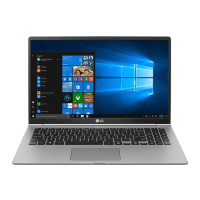
Do you have a question about the LG 15Z990 Series and is the answer not in the manual?
Key notices and guidelines for service technicians.
Pre-service checks and preparations required.
Essential safety rules for handling the equipment.
Precautions to prevent electrical hazards during repair.
Guide for inspecting safety aspects of the product.
Procedures for handling ESD-sensitive components.
Specific warnings and precautions for battery handling.
Identification of components on the front of the laptop.
Identification of ports and components on the left side.
Identification of ports and components on the right side.
Detailed specifications of the laptop's hardware components.
Information regarding network connectivity options.
Weight specifications of the laptop.
Visual representation of the system's internal components and connections.
Explanation of keyboard shortcuts for enhanced usability.
Description of indicator lights and their meanings.
Procedure for updating the system's BIOS.
Steps to enable or verify the Secure Boot option.
Guide to accessing and configuring BIOS settings.
Overview of the BIOS setup main screen and menus.
Details of the BIOS main menu options and system information.
Configuration options for peripherals in BIOS.
Settings for passwords and secure boot configurations.
Options for setting the system's boot order.
Options for saving or discarding BIOS changes.
Using Windows 10 recovery to restore the system to its initial state.
Selecting recovery options like 'Keep my files' or 'Remove everything'.
Using LG Recovery Center RE to fix boot issues.
Steps for performing a factory reset using LG Recovery Center.
Adjusting screen color temperature and system settings.
Registering and using fingerprint for login via Windows Hello.
Setting up PIN, password, and using Windows login methods.
Login convenience and preventing accidental power off.
Installing additional storage and configuring RAID-like features.
Utilizing USB Type-C for charging devices and the laptop.
Troubleshooting issues related to system startup and shutdown.
Steps to diagnose and verify the AC adapter's functionality.
Procedures for checking battery charging and condition.
Troubleshooting audio output problems.
Diagnosing issues with wireless modules (Wi-Fi/BT).
Troubleshooting common display malfunctions.
Methods to identify faulty parts when error messages are unclear.
Procedure for removing the bottom case of the laptop.
Steps for removing and replacing the laptop battery.
Procedure for removing and replacing the Solid State Drive (SSD).
Guidance for installing multiple SSDs and optimal slot usage.
Steps for removing and replacing the system memory (RAM).
Procedure for removing and replacing the laptop speakers.
Steps for removing and replacing the cooling fan and heatsink.
Procedure for removing and replacing the system's mainboard.
Steps for removing and replacing the sub board and associated cables.
Procedure for removing and replacing the fingerprint sensor.
Steps for removing and replacing the touchpad cable.
Procedure for removing and replacing the keyboard deck.
Steps for removing the LCD front bezel.
Procedure for removing and replacing the LCD panel assembly.
Steps for removing and replacing the laptop's webcam.
Procedure for removing and replacing the display hinges.
Steps for removing and replacing the antenna carrier.
List of mainboard part numbers and descriptions.
List of sub-board components and their details.
Part numbers for MiniCard components.
List of memory modules and specifications.
Part numbers for the laptop battery.
Part numbers for webcam modules.
Part numbers for thermal management components.
Miscellaneous small parts and items.
Part numbers for keyboard deck assemblies.
Part numbers for bottom case components and foot rubbers.
Part numbers for LCD assembly, front case, and cables.
Part numbers for power cords.
Part numbers for AC adapters.
Part numbers for various screws used in the laptop.
Part numbers for labels (logos, warnings, IDs).
Part numbers for accessories like keyboards.
